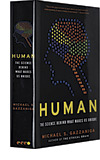A New Way to Look at Human Behavior
A review of Human: The Science Behind What Makes Us Unique, by Michael S. Gazzaniga.
(originally published by Booz & Company)Human: The Science Behind What Makes Us Unique
By Michael S. Gazzaniga
Ecco, 2008, 464 pages
 For centuries, anyone who looked at a globe could see that the east coast of South America fit rather neatly into the west coast of Africa, leading some to argue that they had once been part of the same land mass. But the theory of continental drift was not accepted until the 1960s, when plate tectonics provided a geologic mechanism for the phenomenon. The new paradigm was broadly accepted almost overnight, at least by all those scientists who did not have a heavy investment in the old one.
For centuries, anyone who looked at a globe could see that the east coast of South America fit rather neatly into the west coast of Africa, leading some to argue that they had once been part of the same land mass. But the theory of continental drift was not accepted until the 1960s, when plate tectonics provided a geologic mechanism for the phenomenon. The new paradigm was broadly accepted almost overnight, at least by all those scientists who did not have a heavy investment in the old one.
We may be on the cusp of a similar paradigm shift in our understanding of human behavior. For centuries we have known that humans do not behave rationally in economic terms, but only now are the neurological mechanisms underpinning our behavior becoming clearer. Michael S. Gazzaniga, the director of the University of California at Santa Barbara’s SAGE Center for the Study of the Mind and author of Human: The Science Behind What Makes Us Unique, brings us up to date on this potential shift with the latest discoveries and authoritative thinking from a number of fields, including neuroscience, anthropology, and evolutionary psychology.
The book is divided into four parts, dealing with the neurological differences between humans and chimps, the social world in which we evolved, the many aspects of our humanity, and breaking the constraints of our bodily existence. Its two principal takeaways: First, the brain is not a blank slate on which culture writes its programs. The “modular brain” hypothesis suggests that far from performing like a general-purpose computer, the human brain is a collection of many special-purpose modules that have evolved to cope with problems from our ancestral past. Second, the brain is intensely social in its origins and functions. Several hundred thousand years ago, individuals who cooperated with one another could solve problems together and survive much better than those who didn’t.
The brain may not even “think,” explains Gazzaniga. It may be more like a memory and prediction machine that functions by retrieving and applying patterns learned from the past to new situations. We are capable of “autocueing,” recalling memories independent of the current situation, and we can make predictions by using information that is only contingently true (for example, if it’s Friday, the garbage will be picked up). These two skills give us the ability to create deep analogies and complex models of the world.
This new, emerging view of the brain’s modular nature, together with its many adaptations and improvisations, complicates the organization of the book. The author’s task is made all the more difficult by the book’s encyclopedic scope, which covers everything from brain structure to the role of music and aesthetics in our ability to think. As a result, it is not a smooth read. But if you want an introduction to the topic from someone who has been at the forefront of the new paradigm, you can do no better.![]()
Author profile:
- David K. Hurst is a contributing editor of strategy+business. His writing has also appeared in the Harvard Business Review, the Financial Times, and other leading business publications. Hurst is the author of Crisis & Renewal: Meeting the Challenge of Organizational Change (Harvard Business School Press, 2002).




